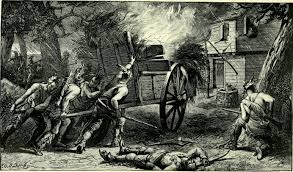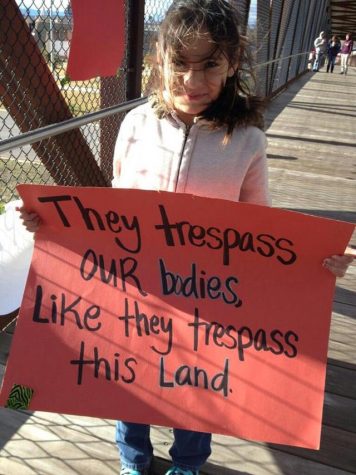How To Really Honor Native Americans on Thanksgiving
November 22, 2019
November is a month centered around Thanksgiving in the United States, one of the most uniquely American holidays that celebrates food and family. There’s feasting, parades, concerts, television specials, and Black Friday. Families come together to eat turkey. Children in schools learn about the Pilgrims and Indians who started the tradition. It’s a day to be thankful and reflect on blessings with some history thrown in.
Unless you’re Native.
For Native/Indigenous/Aboriginal/First Nations people, Thanksgiving is a complicated, often sorrowful day. In the words of United American Indians of New England, “Thanksgiving day is a reminder of the genocide of millions of Native people, the theft of Native lands, and the relentless assault on Native culture.” Since 1970, UAINE has been holding a rally and day of mourning near Plymouth Rock every Thanksgiving. “Participants in the National Day of Mourning honor Native ancestors and the struggles of Native peoples to survive today. It is a day of remembrance and spiritual connection as well as a protest of the racism and oppression which Native Americans continue to experience.”
I’m not saying one can’t enjoy the holidays. Rather, Thanksgiving is a chance to examine a far more nuanced,
tragic history that is always glossed over in favor of comfort. It’s a chance to hear the side of real Natives, who face the same genocide as their ancestors hundreds of years ago.
Instead of honoring English settlers who robbed and killed the people who saved their lives (bet your teacher left that part out), look to the people who are fighting to have their voices heard. Make it a holiday that is truly about coming together by acknowledging the past and looking to the future for unity instead of a whitewashed history. Here are some ways to decolonize Thanksgiving and make it a holiday that’s truly inclusive to Native cultures and peoples.
Learn the Real Story of Thanksgiving

The elementary school Thanksgiving story we learned goes something like this: the Indians, led by Squanto, helped the starving Pilgrims of Plymouth, Massachusetts learn to survive in a new land. The two cultures came together for the first Thanksgiving feast.
While there was a feast involving both Natives and Pilgrims, it wasn’t Thanksgiving. Most indigenous tribes have their own holidays of gratitude. The American holiday wasn’t celebrated until the 1830s or formally recognized until 1863 by President Abraham Lincoln.
Most historians believe that the first “Thanksgiving” was a harvest feast held by the Pilgrims to celebrate their survival. The Wampanoag people unexpectedly showed up after hearing gunfire from a show of arms; Massasoit, their chief, believed they were being attacked. There’s mentions of venison and corn being served, but turkey was not on the menu, as far as we know.
Although the Pilgrims and Wampanoag got along for this one meal, it was downhill for the natives afterwards. Hordes of settlers flocked to the Massachusetts coast, mainly Puritans seeking religious freedom. The religious fundamentalists of their day, Puritans deemed Natives uncivilized and had no trouble pillaging and burning their villages, killing them, and taking their land once disease and warfare diminished their population. The Wampanoag helped the Pilgrims survive, which ultimately led to their downfall.
Learn About Problems Native America Faces

Although colonialism happened centuries ago, the wounds of Native America never healed. As a result of being systemically stripped of land, freedom, and, worst of all, their culture, Natives have high rates of poverty, incarceration, rape, and mental illness.
27% of Natives live in poverty. On reservations, the poverty rate ranges from 23% to 53%. Life expectancy is as low as 65, jobs are scarce, houses are overcrowded and substandard, and voting is sometimes impossible since there are no polling places.
Despite being 9% of the population, Natives make up 29% of prisoners. Natives are the most likely ethnic group to be killed by police. Examples include 14-year-old Jason Pero and mentally ill Paul Castaway.
1 in 3 Native American women face sexual violence in their lifetime. 84% face domestic, emotional, or sexual 
abuse. 86% of these assaults are perpetrated by non-Native men. In Canada and America, there is an epidemic of missing or murdered Native women.
Natural resources are taken from their land but almost never used for their benefit. In cases like the DAPL and fracking on the Pacific Coast, native communities are threatened with the loss of their homes (again) or pollution.
Stereotypes of Natives as barbaric, feather headdress-toting warriors are perpetuated through mascots like the Cleveland Indians, Chicago Blackhawks, and the Washington Redskins. On Halloween and Thanksgiving, people use sacred, heavily stereotyped Native regalia (think headdresses, war paint, buckskin) as costumes to buy into a false idea of what it means to be “Indian.”
The federal government is still trying to steal their land. The Kanaka Moli in Hawaii are protesting to stop a giant telescope from being built on their sacred site of Mauna Kea. The Great Sioux Nation refused $1.3 billion as compensation for being robbed of their land, the Black Hills.
 On Thanksgiving 2016, First Nations protestors were fighting to keep their water and sacred land at Standing Rock Reservation, already one of the poorest areas in the entire country, from being desecrated by the Dakota Pipeline. Police bulldozed burial grounds, cut off the supply lines to protestors’ camps, and attacked the people with water cannons, rubber bullets, dogs, and concussion grenades. Elders, women, and children were among the severely injured. Protestors who were arrested received harsh treatment.
On Thanksgiving 2016, First Nations protestors were fighting to keep their water and sacred land at Standing Rock Reservation, already one of the poorest areas in the entire country, from being desecrated by the Dakota Pipeline. Police bulldozed burial grounds, cut off the supply lines to protestors’ camps, and attacked the people with water cannons, rubber bullets, dogs, and concussion grenades. Elders, women, and children were among the severely injured. Protestors who were arrested received harsh treatment.
In November 2018, the Wampanoag, the tribe who saved the Pilgrims and paid for it, had their reservation threatened when President Donald Trump declared they were not “Indian” enough and did not deserve to have their land protected.
(See references below.)
Support Native Voices
Although the past can’t be changed or amended, the future can. There are multiple ways to combat the effects  of anti-indigenous racism.
of anti-indigenous racism.
Start by telling the truth- talk about the true history of Thanksgiving, colonization, and genocide. When someone starts spewing stereotypes or misconceptions, let it be an opportunity to open up the uncomfortable but real story.
Listen to Native voices when they say something bothers them. Activists expose themselves to hatred, ridicule, and ignorance, and an open ear is always welcome.
Instead of patronizing hippies or Native inspired artists, buy authentic Native goods from actual Native artisans. This is NOT cultural appropriation; it’s appreciation. You’ll be supporting a tribe or artist and enjoying a genuine piece of their culture instead of a cheap, exploitative imitation.
 Watch authentic Native Representation. Instead of Pocahontas or Dances with Wolves, check out movies made by and for Natives. Favorites include Smoke Signals, Songs My Brothers Taught Me, and The Fast Runner.
Watch authentic Native Representation. Instead of Pocahontas or Dances with Wolves, check out movies made by and for Natives. Favorites include Smoke Signals, Songs My Brothers Taught Me, and The Fast Runner.
The Native American genocide is a terrible atrocity that will always haunt America, and Thanksgiving, much like its country, originated from bloody roots. But instead of wallowing in guilt or defensiveness, let the holiday be about unity through listening, compassion, and action. Let Thanksgiving actually be about Native people fighting to reclaim their humanity.
For More Information
- What Does Thanksgiving Mean to Native Americans. https://blog.nativehope.org/what-does-thanksgiving-mean-to-native-americans
- 13 Issues Facing Native Americans Beyond Mascots and Casinos. https://www.huffpost.com/entry/13-native-american-issues_n_55b7d801e4b0074ba5a6869c
- Thanksgiving with a Native American View. https://www.huffpost.com/entry/with-thanksgiving-a-native-american-view_b_5a0cca9ee4b023a796fed3b4
- Op-Ed: Thanksgiving is a tradition. It’s also a lie. https://www.latimes.com/opinion/op-ed/la-oe-orange-thanksgiving-history-20171123-story.html
- Decolonizing Thanksgiving: A Toolkit for Combatting Racism in Schools. https://medium.com/age-of-awareness/decolonizing-thanksgiving-a-toolkit-for-combatting-racism-in-schools-5d4e3023a2f8
- The Wampanog Side of the First Thanksgiving Story. https://newsmaven.io/indiancountrytoday/archive/the-wampanoag-side-of-the-first-thanksgiving-story-TmMLTgQs40aJT_n9T3RMIQ/
- The Thanksgiving Tale We Tell Is a Harmful Lie. As a Native American, I’ve Found a Better Way to Celebrate the Holiday. https://time.com/5457183/thanksgiving-native-american-holiday/?scrlybrkr


